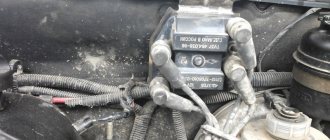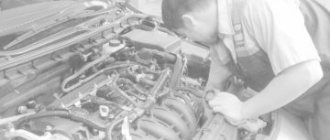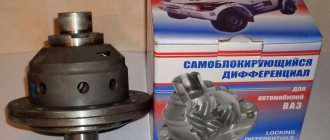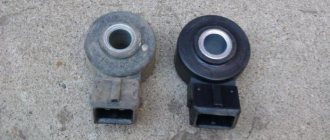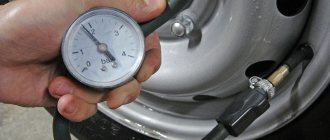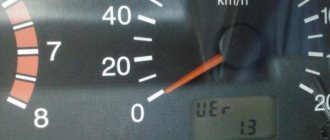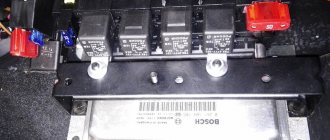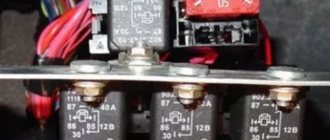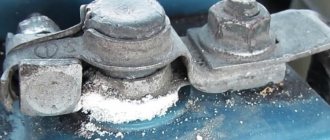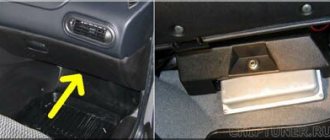After the publication of my article on the topic of oil seals for the Niva, requests began pouring in to write the same regarding bearings and sensors for the 21214 engine, which is installed on Nivas, Niva-Ms, crocodiles and Shnivas. I’ll begin to slowly talk about “trouble-free” sensors, that is, those that you install and forget about for a very long time.
A few general words. Why did this question even arise? Let me give you an example: such garbage as a throttle position sensor (TPS). Since the electronics of our injector are taken entirely from their front-wheel drive counterparts, and their number is very large, a very large number of companies make spare parts for them, and there is no need to talk about the Chinese brothers at all. For some time I even saved up faulty TPS from different manufacturers in a box, after 7 I got lost and threw everything away)) While the factory supplies only two manufacturers.
Another example is the speed sensor. When it’s burned out, it happens that when driving through a puddle, the “check engine” lights up, or the engine simply starts to stall when coasting and nothing lights up. And when you reach the service level, like a wartime exterminator, suddenly the defect disappears. This means that water got inside the case and then also leaked out. So all is well......until the next puddle. One of the most basic sensors is the mass air flow sensor (MAF) , so a separate detailed article is devoted to it.
Crankshaft position sensor - DPKV
The task of this sensor is to read the revolutions of the engine crankshaft and whether it is spinning at all. Perhaps the only sensor that I recommend keeping in your car’s first aid kit (so as not to get lost) as a spare. This is the only sensor without which the injector will not start in principle. Without the rest, the engine will sneeze like a sick person, hiccup, fart, blink the check engine... but rattle. Which means it’s bad, but go. Without DC there will not even be signs of life. Therefore, we will consider it, in medical terms, as setting the heart rhythm. I’ll tell you a little secret, if you are leaving somewhere or leaving the car in a bad place, open the hood and slightly disconnect the DC connector. It is difficult to imagine a more effective anti-theft. The main thing is not to forget about it yourself))
Throttle position sensor - TPS.
The function of this sensor is to provide information to the brain about the position of the gas pedal and the degree of throttle opening. The TPS contains electromechanical parts, that is, a potentiometer. This means that after some time it wears out and the sensor dies. In Russia there are about 10 companies producing this sensor. But I want to draw the reader’s attention to the so-called non-contact (inductive) TPS. It is made by one company, which used to be a “mailbox”. My experience has shown that the sensor in their “non-contact” design is virtually eternal. This is exactly what is shown in the photo.
Air flow
The air flow of the Niva Chevrolet is controlled using a hot-wire sensor, which is located between the hose of the intake pipe and the air filter. The magnitude of the direct current depends on the direction and amount of moving air that passes through it. In the event of a system malfunction, a code is stored in memory and the alarm is activated.
Speed sensor – DS.
The brain uses the signal from the speed sensor to control the engine's idle speed. And support for “pickup” speed while the car is coasting. The actuator of this circuit is the idle air regulator, which controls the air supply bypassing the throttle valve. Enough theory, let's get closer to the people. In fakes based on this sensor, ahead of the original by an order of magnitude - the Chinese brothers. 8 out of 10 sensors that I held in my hands in stores and on the market were made in China. They work for three months, after which they announce their retirement as a “check engine.” What is the difference between the original and the pale one? In the photo, I indicated with arrows where the wires entering the connector are filled with varnish. The seam of the body, which consists of two parts, is also filled with varnish. Mao's heirs consider this unnecessary, and that is why the sensor dies after the onset of the first St. Petersburg slush.
Do-it-yourself replacement of the coolant temperature sensor
To replace the coolant temperature sensor, tools are required, which are presented in the table below.
Table - Tools and materials required to replace the coolant temperature sensor
| Name | Note |
| open-end wrench | "on 10" |
| Wrench | "at 19" |
| Head | "at 13" |
| Vorotok | With extension and ratchet |
| Screwdriver | Medium size, flat blade |
| Rags | For cleaning dirt without leaving lint behind |
In order to replace the DTOZH on a Chevrolet Niva, it is recommended to use the step-by-step algorithm of the instructions below.
- Work should be carried out with a completely cold engine. Therefore, before proceeding with the replacement, if the vehicle is just after a trip, then it is necessary to wait a time interval sufficient for the power unit to cool down.
- Secure the vehicle using the parking brake.
- Open the hood.
- Disconnect the vehicle's power supply. To do this, you need to remove the negative terminal from the battery.
- For easy access to the temperature meter, it is recommended to remove the decorative protective casing of the power unit and the air filter housing.
- By pressing the clamps, remove the terminal from the coolant temperature sensor.
- Unscrew the meter.
- Remove the DTOZH.
- Install a new sensor.
- Reassemble everything in reverse order.
Phase sensor - DF
It's also a camshaft sensor. The VAZ phase sensor is designed to determine the angular position of the camshaft. The main function is that when the engine is running, the phase sensor provides a pulse signal to the controller synchronizing fuel injection with the opening of the intake valves. Failure of the phase sensor switches the fuel supply to pairwise-parallel mode, which leads to a slight (up to 10%) increase in fuel consumption. And I’ll also add this “miracle of nature” is a headache and a source of a lot of errors, for example the famous 0301, 0302.... In my humble opinion, this is the same disgusting and abomination as the old-style hydraulic compensators. But what has grown has grown. (How to get rid of it forever, lambda, roll sensor - will be written in the article about chiptuning). The only normal manufacturer of this sensor is Avtovazagregat. The logo is visible in the photo.
Currently, the production of automobiles has completely abandoned the use of speed measurement sensors consisting of mechanical parts. Modern devices are based on the use of electromagnetic sensors that work due to the effect discovered by the physicist Hall and which received the same name. Such a device allows you to obtain more accurate data about the speed of the car and transmit it to the driver so that they can timely assess the situation.
What is a sensor
In the cylinder head of each car there is one or a pair of camshafts, on which there are petals that are necessary for the normal operation of the exhaust and intake valves. The cylinder block contains a crankshaft, thanks to which torque occurs from the movement in the piston block, transmitted via gears, a belt or timing chain to the camshaft itself. And thanks to the camshaft sensor, the computer determines in the engine which cylinder is on stroke in order to correctly adjust it relative to the position of the crankshaft. This sensor affects how much gasoline consumption will be and how much emissions will be in the exhaust.
One of the most common types is:
- Magnetic sensors
- And which are based on the Hall effect
They transmit a voltage signal to the on-board computer or to the car's engine control unit.
The first type is magnetic; it reproduces its own alternating current, which has two wires; it is also called a sine wave. The second type, based on the Hall effect to obtain a digital signal, uses an external power source and already has three wires. There may be several sensors in a car.
Basic functions of the device.
To control the speed of movement, a special device is installed on the dashboard - a speedometer. But it only displays the information received, and the speed sensor is responsible for collecting data. If it fails, it will create many dangerous situations on the road, since it will become difficult to control the speed limit in the city and on the highway.
But besides this, thanks to the integration of the electronic control unit into the system, the speed sensor allows you to perform the following functions:
- fuel consumption control
- displaying information on the instrument panel
- in cars with an automatic transmission it is included in the complex responsible for engine control
In case of failure, you are allowed to continue the journey, but this will become difficult.
Historically, there were two types of sensors. Initially, mechanical or optoelectronic were used. They read the number of shaft revolutions, transmitting it to the instrument panel using a cable. Then electronic cableless systems came to replace them.
Features of the VAZ-2123 engine control system
The VAZ-2123 car engine is equipped with a microprocessor control system (MSUD), i.e. a distributed fuel injection system with feedback, which combines the inextricably linked power and ignition subsystems.
Both subsystems are controlled in a complex by an electronic control unit (ECU), which receives information about the state of the engine from sensors that monitor various operating parameters of the system.
The location of the sensors is shown in Fig. 1.
It is called distributed injection because fuel is injected into each cylinder using a separate injector.
The fuel injection system reduces exhaust emissions while improving the vehicle's driving characteristics.
Rice. 1. Location of engine control system elements in the engine compartment
The VAZ-2123-40 MSUD installed on a car with a Bosch MP7.OH controller (2123–1411020–10) meets Euro II toxicity standards.
This system uses a synchronous fuel supply method.
The injectors are turned on in pairs and alternately: first, the injectors of the 1st and 4th cylinders, and after 180° of rotation of the crankshaft - the injectors of the 2nd and 3rd cylinders, etc.
Thus, each injector is turned on once per revolution of the crankshaft, i.e. twice per full engine operating cycle.
To achieve Euro IV toxicity standards, the phased injection method can be used on some vehicles.
In this case, a phase sensor is additionally installed on the engine, which determines the moment of the end of the compression stroke in the 1st cylinder, and fuel is supplied by injectors to the cylinders in a sequence corresponding to the ignition order in the cylinders (1–3–4–2).
The ignition system does not use a traditional distributor and ignition coil.
This uses an ignition module consisting of two ignition coils and high-energy control electronics.
The ignition system has no moving parts and therefore requires no maintenance.
It also has no adjustments (including ignition timing), since the controller controls the ignition.
The ignition system uses a spark distribution method called the "idle spark" method.
The engine cylinders are combined in pairs 1–4 and 2–3, and sparking occurs simultaneously in two cylinders: in the cylinder in which the compression stroke ends (working spark), and in the cylinder in which the exhaust stroke occurs (idle spark).
Due to the constant direction of current in the windings of the ignition coils, the sparking current for one spark plug always flows from the central electrode to the side electrode, and for the second, from the side to the central one.
The controller controls the ignition in the system.
The crankshaft position sensor provides a reference signal to the controller, on the basis of which the controller calculates the firing sequence of the coils in the ignition module.
To accurately control the ignition, the controller uses the following information:
– crankshaft rotation speed;
– engine load (mass air flow);
– coolant temperature;
– position of the crankshaft;
Photo 3 shows the location of the EMS elements of a car from 2009.
Since 2015, the VAZ-2123 car has been equipped with an electronic engine management system with an ME17.9.71 2123-1411020-50 controller that meets EURO-5 toxicity standards.
The electronic engine control system (ECM) consists of a controller, sensors for engine and vehicle operating parameters, as well as actuators.
The controller is a special-purpose mini-computer that consists of random access memory (RAM), programmable read-only memory (PROM) and electrically reprogrammable memory (ERM).
Device location.
Each vehicle is equipped with only the appropriate equipment, designed for a certain number of shaft rotations and installed in the appropriate seat. The Chevrolet Niva speed sensor is installed on the gearbox.
The sensor itself is a small steel or, more often than not, plastic device that is mounted in the shaft area. Inside the case there is a core that transmits impulses to a special controller responsible for displaying information on the instrument panel.
When carrying out work, it should be taken into account that the device can be quite fragile, so installation should be carried out with care.
Basic principles of system operation
The Hall effect is the principle of reading electromagnetic pulses. There are magnetic marks on the car shaft, the impulse from which is read by the sensor. A certain number of shaft rotations is programmed into the control unit, corresponding to the kilometer traveled, equal to 6004. As the speed increases, the interval between pulses is reduced, the information is processed and displayed on the instrument panel.
Detonation very often occurs when going uphill. In this case, the car is moving slowly, and the speed is increased. But do not worry, since this phenomenon is called glow ignition, and it does not indicate that the engine is not working properly.
Any internal combustion engine works according to the following principles:
- A mixture of gasoline and air is supplied to the combustion chamber of the cylinders, where it is ignited by a spark on the spark plug. Moreover, the piston should be literally a few millimeters from top dead center. As soon as the piston reaches the top position, the greatest pressure is generated in the cylinder. At this moment, the entire air-fuel mixture will completely burn.
- During normal operation of the knock sensor on the Chevrolet Niva, signs of this phenomenon will not appear. This device will help get rid of the manifestation of detonation. And it appears when the mixture begins to ignite much earlier than it should. This usually happens halfway to top dead center. And when the air-fuel mixture burns, a force is exerted on the upper part of the piston, which pushes it in the opposite direction. At the same time, the engine power is reduced, and significantly, and its parts wear out.
Main types of faults.
Like any car part, the sensor is subject to vibration and is susceptible to contamination and oxidation. Therefore, its failure is possible from time to time. To understand the cause of the breakdown and what to do in each specific situation, the following problems should be eliminated:
- broken wiring
- the appearance of oxide on the contacts
- destruction of wire insulation
- mechanical damage to the housing or its internal components
To do this, you can carry out a certain set of measures to check the condition of the sensor. Typically, such work requires a multimeter. The sensor is removed from the seat. A positive probe is connected to the contacts. The negative one is connected to the ground of the vehicle. The multimeter must be set to minimum power measurement mode. A tube is placed on the sensor shaft and by rotating it an increase in voltage should be observed. If this is not observed, then the sensor is considered faulty.
There is a second diagnostic method. This does not require dismantling the sensor. The car is raised with a jack, then a multimeter is connected to the sensor. To appear, you need to rotate the wheel, observing the readings of the device. If the value does not change, the sensor is faulty.
Typical breakdowns
Be sure to listen to how the engine operates as the load increases - if even the slightest metallic clatter appears, be sure to make a diagnosis.
Otherwise, you may experience the following problems:
- Burnout of the gasket under the cylinder head. When detonation occurs, the engine temperature increases.
- Destruction of the pistons, as they all corrode.
- Very often, elements of the crank mechanism and cylinder head are destroyed.
If you are driving your car up a hill and the gear is in high gear, be sure to monitor the engine. If you subject the engine to heavy loads, you will contribute to the appearance of detonation knocks. As a result, many elements of the car will fail, and this is the first step towards a major overhaul.
Replacing a faulty Chevrolet Niva speed sensor.
The work is carried out in an inspection pit. Before dismantling, you must disconnect the battery.
The sensor is located on the rear cover of the transfer case. Before removing it, you must disconnect the terminals. They are held in place by a plastic retainer.
Then, using a wrench, the device is unscrewed from the seat.
If the device is firmly “stuck”, it is forbidden to use excessive force; it is better to treat the threads with a lubricant like WD-40.
Before installing a new device, you should carefully examine its condition. On the sensor, the assembly points and contact group must be carefully filled with varnish to prevent the penetration of water. Otherwise, the device may soon fail.
What to do in case of malfunctions
Due to the fact that the on-board wiring on the car suffers from low reliability. The DD check must be performed in stages. In the event of a malfunction, you should walk along the entire line, including the sensor, and visually assess its condition. If individual sections of the chain have apparently lost their integrity, they are replaced.
If replacing the wiring does not help, you need to dismantle and check the sensor.
Removing the sensor
Dismantling the device is quite simple. This does not require special tools or deep knowledge of mechanics. The part has one contact group and is attached to the engine block using a bolt with a No. 10 head. To remove it, you need to disconnect the wires and unscrew the fixing screw.
